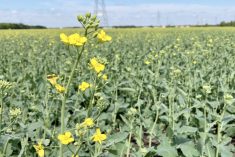(Resource News International) Canada continues to monitor its soybean crops
very closely for any signs of the Asian soybean rust disease, but
so far no viable spores have been found, said an Ontario provincial crop specialist.
“There has not yet been a confirmed case of Asian soybean
rust in Ontario,” said Peter Johnson, a cereal specialist with the
Ontario Ministry of Agriculture, Food and Rural Affairs.
Ontario officials have been monitoring
for Asian rust as part of the national protocol that has been
Read Also

Senft to step down as CEO of Seeds Canada
Barry Senft, the founding CEO of the five-year-old Seeds Canada organization is stepping down as of January 2026.
“There have been on two separate occasions this year, a
positive identification of rust spores in the traps in Ontario,
but they were not viable spores,” Johnson said.
There need to be clusters of spores in order to
make the disease viable, he said. “The population of spores that are being carried this far
north in the wind have not included clusters.”
A monitoring system was established in Canada several years ago to look for any signs of the disease.
Asian soybean rust, common throughout Asia and
South America, was discovered in the fall of 2004 in nine U.S.
states, and was expected to eventually find its way to Canada
through wind-borne spores.
Johnson said Canada has been preparing for years, knowing
full well the disease would endanger the country’s soybean
output.
While Asian soybean rust has not
infected the crop in Ontario, it was no longer a matter of if,
but when, he indicated.
The disease generally is able to
overwinter in the southern U.S. states on a plant called kudzu.
Kudzu is a type of legume, a flowering plant that bears
protein-rich seeds in pods and can fix nitrogen in the soil. Its
tubers are edible and the fiber is useful. The plant has a woody
stem, wide leaves and purple flowers. Kudzu is native to Japan
and was introduced to the U.S. around 1876. However, it
has became a nuisance weed in the southern U.S.
In the south, where winters are moderate, the first frost
will turn kudzu into dead leaves and, soon after, just gray vines.
The kudzu vine will, however, continue growing the next summer
almost from where it was stopped by cold weather the previous
year.
Asian soybean rust is not harmful to humans or animals, but
it does have a crippling effect on soybean plants and yields.
Symptoms include small lesions on the lower leaves of the
infected plant that increase in size and change from grey to tan
or reddish brown on the undersides of the leaves. Soybean rust
can be managed with early detection and the use of fungicides.
“We’re really at the mercy of weather patterns from the
U.S. for this disease,” Johnson said, noting the
key to managing the disease is early detection.


















